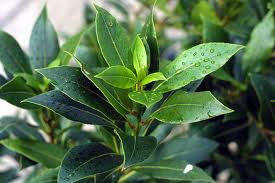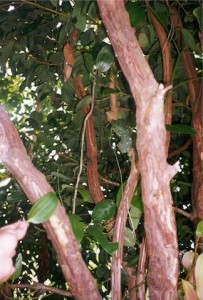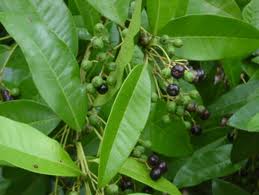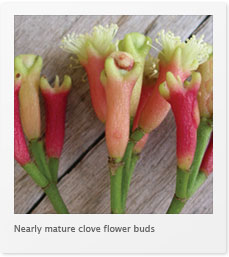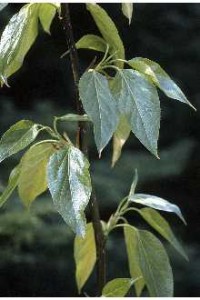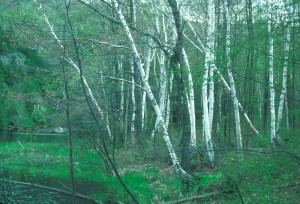When we think of herbs, we tend to think of shrubby, herbaceous plants growing in an herb garden or container.
In fact, one of the accepted definitions of an herb is: “a small, seed bearing plant with fleshy, rather than woody, parts.“ But, we also find this definition: “Any plant with leaves, seeds, or flowers used for flavoring, food, medicine, or perfume.” I would add to that list of plant parts: roots and bark. Let’s take a look at some common and not-so-common trees that qualify as herbs due to their culinary, medicinal or other uses.
This Herb grinder is the best way to grind bark and other woody parts of herbal trees and others herbs for medicinal use.
Bay Laurel, Cinnamon, Allspice and Cloves
The trees I am most familiar with as herbs are the ones we use in our cooking adventures. Bay Laurel, Cinnamon, Allspice and Cloves come to mind immediately. With Bay Laurel, Laurus noblis, we use the leaves either fresh or dried. With the others, we use the fruit, bud or bark.
Bay leaves are evergreen, dark and shiny.
True cinnamon comes from the bark of the Cinnamon Tree, Cinnamomum zeylanicum.
Allspice comes from the dried berries of the Pimenta dioica tree.
Cloves are the unopened flower buds from the Syzygium aromaticum tree, a close relation to the Allspice tree.
Cinnamon, Allspice and Clove trees are commercially grown in the tropics, although of the trio, only Allspice is native to the Western hemisphere, being indigenous to the West Indies and Central and South America. Cinnamon is believed to be native to Sri Lanka while Cloves seem to have originated in the Molucca Islands in the Indian Ocean. Bay Laurel is native to the Mediterranean region.
Many, if not most, of the herbs and spices we use from trees for culinary purposes also have medicinal properties. The above species are no different.
Bay Laurel seems to be one herb whose medicinal properties are not lauded, leaving it for culinary and ritual uses. However, Laurus nobilis, the common bay tree, has a host of medicinal properties. It is anti microbial and bactericidal, making it useful for tooth decay, ridding the scalp of dandruff, relieving the effects of a bee sting and soothing aches and pains. (Here is more information of some of the healing properties of Bay Laurel.)
The ritual uses of Bay Laurel are many. From crowning the original Olympian athletes, as well as Greek poets and scholars, to crowning today’s Boston Marathon winners with a wreath of Bay Laurel, it has had a place in history for centuries.
Allspice is the most important of the few spices native to the West. A local drink in Jamaica is pimento dram, made from the ripe berries and rum. Allspice was used by the Mayans as an embalming agent and by other South American Indians to flavor chocolate.
The name Allspice is applied to other aromatic shrubs, particularly the genus Calycanthus but these have no connection with the allspice of the kitchen.
By the mid 18th Century, Allspice was a common import to England. It was first mistaken for a kind of pepper which is where the Genus name Pimenta came from.
During the Napoleonic War of 1812 Russian soldiers put allspice in their boots to keep their feet warm. Jamaicans have long believed allspice to be an aphrodisiac, and suggest alluring ways of using it by giving your lover a rose with an allspice berry implanted in it or making a tea with allspice berries and orange peel for someone special.
An orchard of allspice trees is called a “walk”, which I think is a lovely name for an orchard.
There are hundreds of trees that have been used for medicine around the world. Obviously, this could be a life long study, but here are a few I thought might be of interest.
Magnolia:
There are several types of Magnolia. One, which we in the U.S. know as the Southern Magnolia, Magnolia virginiana, has many of the same uses as the Chinese varieties, Magnolia officinalis and Magnolia liliflora.
In China, Magnolia buds have been used to flavor rice and make medicine more palatable. Tea made from the bark of Magnolia was used as a substitute for quinine to treat malaria or typhoid. Sometimes the bark was chewed to aid in cessation of tobacco use.
Essential Oil from Magnolia flowers has been used in the perfume industry.
Ginko biloba:
Ginko biloba is well known in the West, although it originates in Japan and China. The tree has a graceful look with fall interest as the leaves turn a lovely golden color. If you’re planning to plant a Ginko tree, it might be best to purchase a tree that is guaranteed to be a male, due to the ripe, unpleasant odor of the fruit on a female tree.
The tree is ancient. It is the oldest living tree species, dating back to the Permian period, some 200 million years ago. No one knows when the last Ginko trees grew wild, but for centuries Chinese monks cultivated the plant, keeping the species alive.
Ginko has been studied exhaustively due to its use as a memory and concentration enhancer. It seems to improve blood flow to all cells, including the brain, where it oxygenates the cells.
The world’s largest plantation of Ginkgo trees is in Sumter, South Carolina, consisting of almost 1000 acres of sandy soil with millions of trees planted 40 inches apart (about 25,000 trees per, approximately, every 2.5 acres). They are kept shrub-sized. The gathering of the leaves starts mid-July when the leaves are still green. Every 5 years the trees are cut down to the ground!
More information on Ginko biloba
Eucalyptus:
Eucalyptus branches are a familiar sight in dried arrangements.
The tree is well-known in parts of California as a big, somewhat messy landscape tree. Herbally, Eucalyptus, Eucalyptus globulus, is prized for its use as a tea in treating coughs, colds and other respiratory issues. Gargling with a strong infusion of the leaves can help relieve a sore throat.
The essential oil found in Eucalyptus leaves is a powerful antiseptic and is used in many over-the-counter remedies for coughs, sore-throats and colds. Extracts of the leaves have antibacterial activity as well, and can be used on cuts, skin abrasions, etc.
Here are a few other trees native to the U.S. with surprising medicinal properties:
Balsam poplar (Populus balsamifera)
Growing across the northern reaches of North America, balsam poplar bears buds coated with a gooey, fragrant substance. In the drug industry, it’s called “balm-of-Gilead,” and as an expectorant, it becomes a constituent of cold medicine. It also keeps ointment from going rancid. Applied externally, it helps heal wounds.
Birch (Betula papyrifera, nigra, lenta )
Native to northern and eastern North America, birch trees possess concentrations of salicylic acid, the predecessor of aspirin. Although birch products were never widely used, folk medicine called for chewing birch twigs to relieve headache and pain. Willows (Salix spp.) also contain the pain-reducing acid.
Dogwood (Cornus florida)
A medicine made from the bark of this tree native to the eastern United States often has been substituted for quinine. During the Civil War, Confederate doctors used it to treat malaria cases. Although it grows in abundance, drug companies looked past it to the more powerful quinine that comes from the cinchona tree of South America and the tropics.
I hope this little excursion into herbal trees has given you a wider appreciation of the properties of so many of the plants around us. I have barely skimmed the surface of the value of the many various types of trees all around the world that have, for ages, been of aid to people everywhere.
Perhaps the next time you hear someone trying to define what is an “herb”, you’ll remind her (or him) of the many herbal properties of the bigger, woodier members of the herb family.
QUOTE FOR THE MONTH
Of all the preposterous assumptions of humanity over humanity, nothing exceeds most of the criticisms made on the habits of the poor by the well-housed, well-warmed, and well-fed.
-Herman Melville, novelist and poet (1819-1891)

